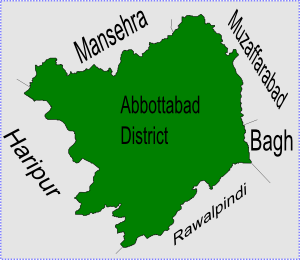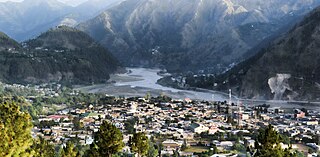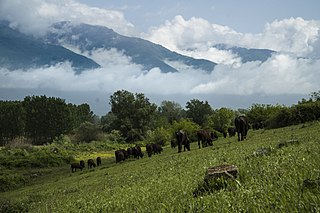
Khyber Pakhtunkhwa, formerly known as North West Frontier Province (NWFP), is a province of Pakistan. Located in the northwestern region of the country, Khyber Pakhtunkhwa is the fourth largest province of Pakistan by land area and the third-largest province by population. It is bordered by the Pakistani provinces of Balochistan to the south, Punjab to the south-east, the territory of Gilgit-Baltistan to the north and north-east, Islamabad Capital Territory to the east and Azad Kashmir to the north-east. It shares an international border with Afghanistan to the west. Khyber Pakhtunkhwa has a varied landscape ranging from rugged mountain ranges, valleys, plains surrounded by hills, undulating submontane areas and dense agricultural farms.

The North-West Frontier Province was a province of British India from 1901 to 1947, of the Dominion of Pakistan from 1947 to 1955, and of the Islamic Republic of Pakistan from 1970 to 2010. It was established on 9 November 1901 from the north-western districts of the British Punjab, during the British Raj. Following the referendum in 1947 to join either Pakistan or India, the province voted hugely in favour of joining Pakistan and it acceded accordingly on 14 August 1947. It was dissolved to form a unified province of West Pakistan in 1955 upon promulgation of One Unit Scheme and was reestablished in 1970. It was known by this name until 19 April 2010, when it was dissolved and redesignated as the province of Khyber Pakhtunkhwa following the passing of the Eighteenth Amendment to the Constitution of Pakistan, by President Asif Ali Zardari.

Amb or the State of Amb was a princely state in the present day Khyber Pakhtunkhwa region of Pakistan. Together with Phulra, it was known as Feudal Tanawal ruled by Tanoli tribe. A Royal Tenure start from Timurid Empire and end on Last Nawab Muhammad Farid Khan Tanoli. Amb was only powerful state incorporated in Pakistan with armed civilized military of 12,000 men, 300 Howitzer with their own manufacturing arms factory, today part of the Pakistan Army. Amb had a influence control roots in Swat, Dir and Chitral. A gaining of powerful roots of Amb military start from Second Anglo-Sikh War when East India Company provide military equipment to Jehandad Khan Tanoli to fight against Sikh, and then next British Empire in Second anglo-Afghan War. At the end of December 1947, the Nawab of Amb state acceded to Pakistan while retaining internal self-government. Amb continued as a princely state of Pakistan until 1969, when it was incorporated into the North West Frontier Province.

Hazara is a region in northern Pakistan, falling administratively within Hazara Division of the Khyber Pakhtunkhwa province. It is dominated mainly by the Hindko-speaking Hindkowan people, who are the prominent people group of the region and often called the "Hazarewal".

Gujrat is a district in the Pakistani province of Punjab. It is geographically located between the Chenab and Jhelum rivers and headquartered at the city of Gujrat.

The valley of Agror is located in the Hazara region of the Khyber-Pakhtunkhwa province of northern Pakistan. Its territory makes up Oghi Tehsil, an administrative unit of Mansehra District. Khans of Agror belonging to Begal subsection of Mitravi Swatis are ruling this area since 1703 conquest of Pakhli. Agror is the Pashto speaking area where Swatis speak pashto as their mother tongue.
The history of Peshawar is intertwined with the history of the broader Indian subcontinent. The region was known as Puruṣapura in Sanskrit, literally meaning "city of men". Being among the most ancient cities of the Indian subcontinent, Peshawar had for centuries been a center of trade between West Asia, Central Asia, and the Indian subcontinent.

Kasur District, is a district located in Lahore Division of Punjab, Pakistan. It came into existence on 1 July 1976. Prior to its creation, it was a tehsil of the Lahore District.

Sherwan is a Tehsil from the Abbottabad District in the Khyber-Pakhtunkhwa province of Pakistan, located 35 km west of Abbottabad. Sherwan consists of two adjacent villages. The northern part is referred to as Sherwan Kalan, and the southern as Sherwan Khurd. Sherwan is on a ridge 5,000 feet high in the centre of Lower Tanawal.

Hindkowans, also known as the Hindki, is a contemporary designation for speakers of Indo-Aryan languages who live among the neighbouring Pashtuns, particularly the speakers of various Hindko dialects of Western Punjabi (Lahnda). The origins of the term refer merely to the speakers of Indo-Aryan languages rather than to any particular ethnic group. The term is not only applied to several forms of "Northern Lahnda" but also to the Saraiki dialects of the districts of Dera Ghazi Khan, Mianwali, and Dera Ismail Khan, which border the southern Pashto-speaking areas.

Banda Pir Khan is one of the 51 union councils of Abbottabad District in Khyber-Pakhtunkhwa, Pakistan.
Dhodial is a town and union council located near Baffa between Mansehra and Shinkiari in Mansehra District in Khyber Pakhtunkhwa province of Pakistan. Dhodial is a fertile region known for its vegetables and tobacco crop. Dhodial is also well known for its pheasant conservation project. The town was badly affected by the 2005 Pakistan earthquake.

'Siran Valley is a beautiful valley situated near the banks of Siran River in Pakhli region of District Mansehra, Khyber Pakhtoon Khwa, Pakistan. Swati is the biggest landlord family of this Valley. Siran valley consists of many union councils including Bhogarmang and Sacha Kalan.

Garhi Habibullah is a town and union council of Mansehra District in the Khyber-Pakhtunkhwa province of Pakistan. It is located in Balakot Tehsil and lies to the east of district capital Mansehra, towards the Kashmir frontier. It was affected by the 2005 Kashmir earthquake.

The History of Khyber Pakhtunkhwa refers to the history of the modern-day Pakistani province of Khyber Pakhtunkhwa.
Battagram Tehsil is an administrative subdivision (Tehsil) of the Battagram District in the Khyber Pakhtunkhwa province of Pakistan. It serves as the Tehsil headquarters and covers a total area of 300 square miles (780 km2). Battagram Tehsil merged into Pakistan as an administrative region before being raised to the status of a district in 1993. On October 8, 2005, a 7.6 magnitude earthquake in Kashmir badly affected the area.

Baffa Pakhal is the fourth tehsil of Mansehra District in Khyber Pakhtunkhwa province of Pakistan. . The capital of Baffa pakhal is Baffa. Baffa Pakhal has at least 15 union councils, some of which are Dodial, Shinkiari, Suma Allimung, Schain, Jabar Daveli, Ichrian, Ail, Tanda, Baffa, Anayatabad, Hilkot, Tarangri Sabir Shah and Bhogarmang. Main language of the tehsil is Pashto followed by Hindko. Majority of lands in all Union Councils of Baffa Pakhal belongs to 8 families of Gabri Swatis.

Babar Saleem Swati also known as Babar Saleem Khan Jahangiri is a Pakistani politician and landlord who is the Speaker of the Provincial Assembly of Khyber Pakhtunkhwa since 29 February 2024. He is member of the Provincial Assembly of Khyber Pakhtunkhwa from the constituency PK -37 Mansehra -II. Previously, he was a member of the Provincial Assembly from 2018 to 2022 and served as Advisor to the Chief Minister on Home and Tribal Affairs from October 2022 till January 2023. He belongs to the Jehangiri family within the Swati tribe of Mansehra.

Hinduism is a minority religion in the Khyber Pakhtunkhwa province followed by 0.02% of the population of the province as per 2023 Census.























